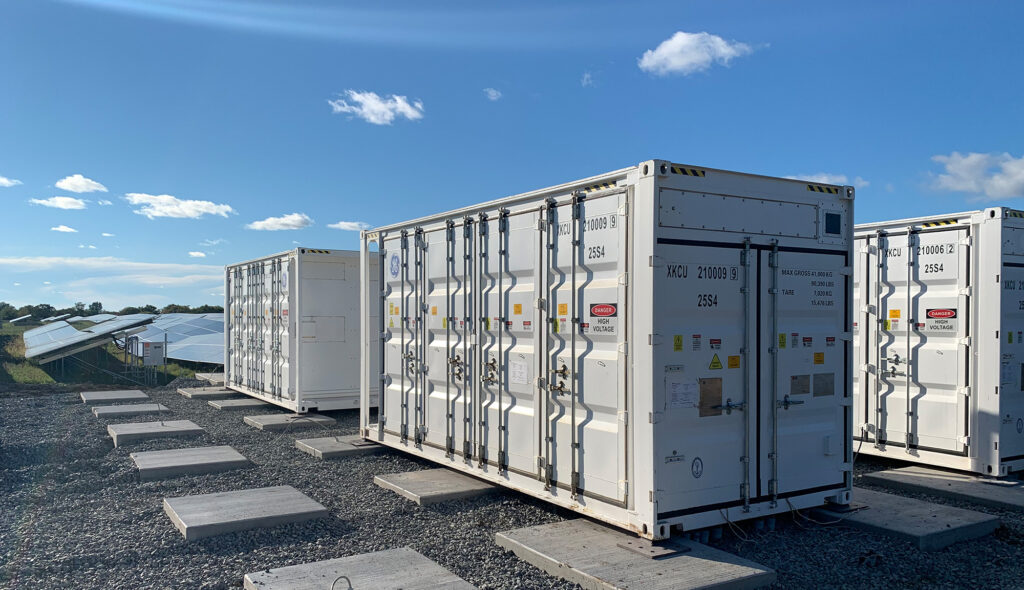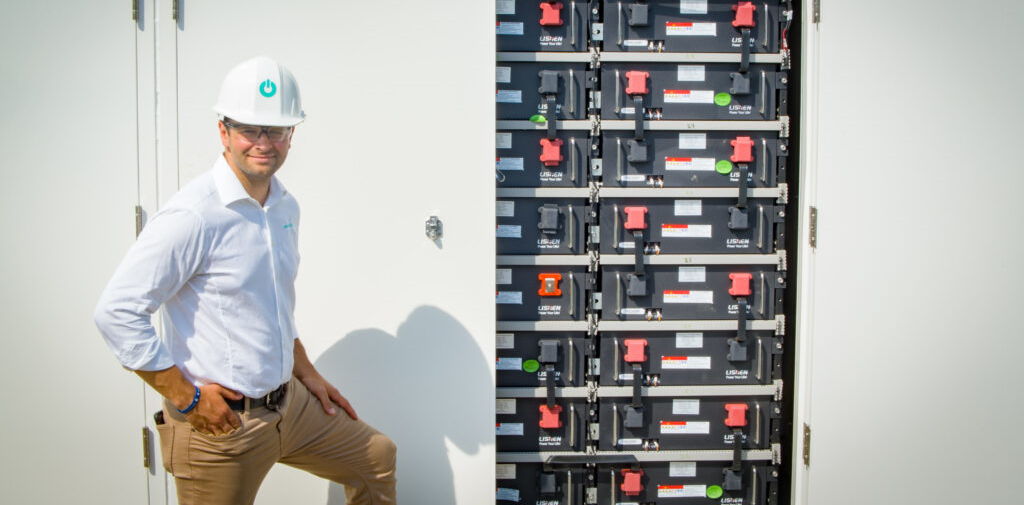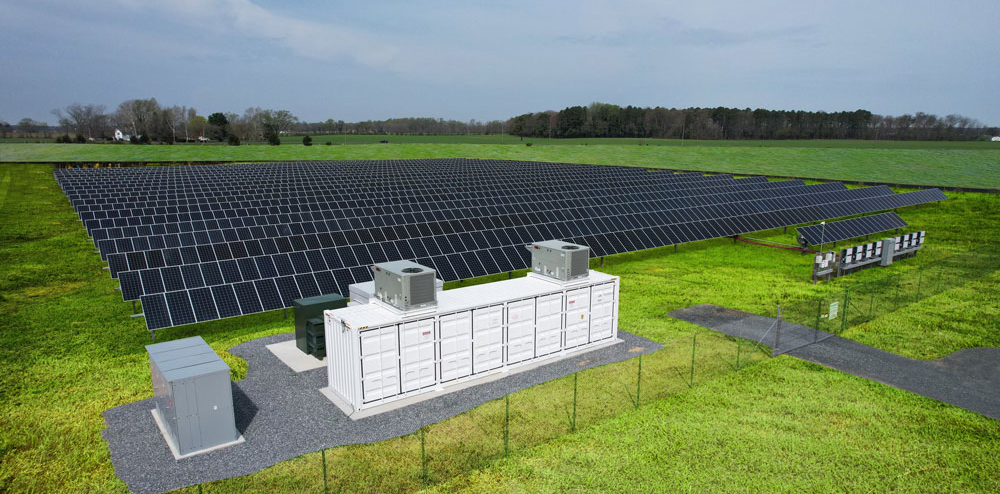June 23, 2022 | Laura Meilander, Vice President Business Development and Derek Longo, Senior Vice President, Project Execution and Operation

Rapid Growth: The Energy Storage Sector Today
Utility-scale battery energy storage system (BESS) installations in the US grew 196% to 2.6GW in 2021 according to the American Clean Power Association (ACP). Measured in energy, utility-scale BESS capacity quadrupled to 10.8 GWh over the course of the year.
Today, the ACP notes 187 projects in the 12.5GW pipeline for battery storage – of which 48 are stand-alone with 139 hybrid (paired with a renewable power source).
The market is growing and the time is right to start thinking about how storage can integrate within your utility system.
Why Energy Storage: What can Energy Storage do for Your Utility?
Historical transmission rates have gone up by double digits in many markets, including ISO-NE, ERCOT, PJM-AEP, and MISO. We’ve seen a huge increase in transmission costs, and we’ve been seeing more transmission owners investing money into infrastructure (which only means that rates are going to continue to increase).
For utilities looking to reduce capacity and transmission costs—or hedge against future cost increases—energy storage is an optimal solution. Often referred to as the “Swiss Army knife” of solutions, the versatility of energy storage can do many things, depending on the application.
The primary benefits of energy storage includes reducing costs for utilities (and your communities). Other benefits include decreasing carbon emissions and integrating or maximizing renewable energy, and improving reliability. Energy storage can provide benefits to your utility on its own, or paired with solar energy (solar-plus-storage).
Further, the features of battery storage (the most common form of energy storage), include a small footprint, quiet and pollution-free operations, instantaneous response, and the ability to provide added capacity during grid peaks, making it an ideal solution for utilities.
Top Three Benefits of Energy Storage for Utilities
There are many benefits of energy storage to utilities and their customers but those benefits partly depend on the application. Regardless of the application, however, these are the top three benefits of utility-scale energy storage:
1: Cost Savings.
With inflation and increasing transmission costs, we know that reducing costs is a top priority for utilities and their customers. Energy storage can add capacity, which provides diverse services to utilities, such as lower costs and new revenue streams. Ultimately, utilities will be able to pass any savings from an energy storage system on to their customers (members or ratepayers) in the form of lower electricity bills. These services include peak shaving (coincident and non-coincident), frequency regulation, voltage support, demand response, system resiliency, and emergency power during critical outages, among others.
Energy storage is also an instrumental tool in the Non-Wires Alternative (“NWA”) toolkit – a category of projects that includes energy storage, DERs, energy efficiency, and demand response – that aim to defer or eliminate the need for traditional, costly, transmission and distribution infrastructure upgrades. In other words, because energy storage allows utilities to defer or eliminate the need for infrastructure upgrades, those costs are also deferred or eliminated, benefitting both the utilities and their customers.
Generally speaking, Convergent’s customers will save around seven-figures over the life of a battery storage system or solar-plus-storage system, depending on their capacity and transmission costs or peak demand costs, their risk tolerance, and other variables. In some cases, utility customers can save their communities around 10 million dollars over the life of the system. For a custom quote, please reach out to us!
2: Sustainability.
To meet the electric grid’s highest periods of consumption, also known as “peak demand,” utilities often rely on natural gas peaker plants, which can quickly ramp up production to meet the needs of the grid. Those plants, however, are expensive, oftentimes inefficient, and carbon-intensive. On the other hand, battery storage systems (especially when paired with solar), produce zero on-site greenhouse gas emissions and may be deployed to augment peaking capacity or replace the need for peaking generation entirely!
The battery storage system is typically charged during off-peak times using clean energy and discharges during peak times, thus replacing fossil fuel generation. In this way, battery storage can defer the construction of new peaker plants, expedite the retirement of existing fossil generation, and avoid costly transmission and distribution system upgrades. New York and Massachusetts have both established “Clean Peak” and “Time-of-Use” standards for this purpose, developing a market for renewable energy players to accelerate the pace of renewables and energy storage deployment. Energy Storage helps to enhance grid resiliency and power quality by providing benefits to the electricity grid more broadly.
3: Reliability.
Historically, power on the grid has flowed in one direction (from generation to transmission to distribution to customers) but with more and more customers producing their own power, i.e., solar panels at businesses or residences, power is now flowing in multiple directions. The grid was not built for this. Nor was it built for the proliferation of extreme weather events produced by climate change.
The future of energy depends on our ability to store it.
Energy storage can increase reliability in multiple ways. First, energy storage can “firm up” renewable resources, maximizing their value to the grid. Second, by increasing capacity and resiliency on the grid at the most strategic times, intelligently deployed energy storage avoids or defers the need to build out new infrastructure (wires), which is called a Non-Wires Alternative. Third, energy storage can provide additional local and system capacity at the most critical times.
Energy Storage: Key Decisions and Next Steps
When it comes to energy storage, there are a few key decisions to make including whether to own the system outright or contract for its services with a partner like Convergent. There are benefits to both options, and we try to help customers find the best solution for their needs. You can read more about owning versus contracting a battery storage system in a recent blog post.
Once you decide whether or not you want to own the system, other key decisions will fall into place (the system size and location, the type of technology, operations, and maintenance).
Energy Storage Adds Value Immediately: Start the Conversation Today!
Energy storage is necessary for our power system; it’s the key to not only saving your community money but also creating a more flexible grid.
The future of energy storage is now. We’re having more and more conversations with utilities that are looking to deploy a battery storage system to reduce costs, increase sustainability, and improve reliability.
It’s an exciting time for us at Convergent; it’s rare that a business creates a win-win-win. Our energy storage solutions are a win for our customers, (a win for us!), and a win for communities and the environment.
If you’re interested in learning more about how energy storage can benefit your utility, please contact us today for a free, customized evaluation.

Laura Meilander serves as Vice President, Business Development at Convergent. Before joining Convergent in 2019, Laura spent over 20 years in the utility and energy industries. Laura has worked in the power origination groups at Constellation Energy, Deutsche Bank, and JP Morgan where she developed, negotiated, and executed structured wholesale energy transactions in PJM, MISO, ERCOT, and the Northeast.

Derek Longo serves as Convergent’s Senior Vice President, Project Execution and Operations. For the last 5 years, Derek has overseen all phases of project execution and asset operation including utility interface, technical coordination, supplier oversight and expediting, project budgeting, installation, commissioning of project equipment, and planned and unplanned maintenance.
Join our Mailing List
Stay up to date on the latest news and insights in energy storage.
–



